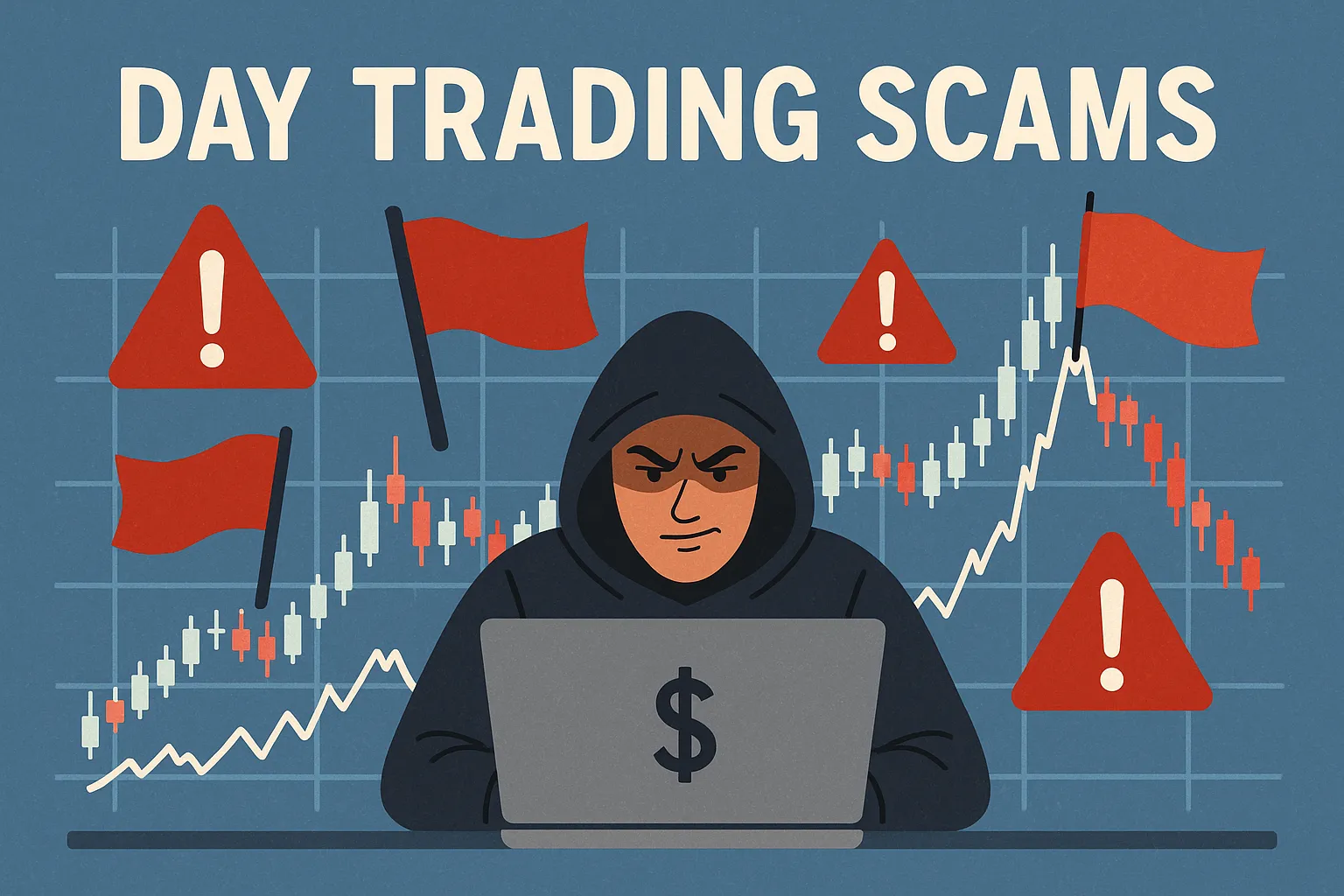- Promises of guaranteed returns
- Pressure for immediate investment
- Unverifiable track records
- Complex fee structures
- Limited withdrawal options
Day Trading Scams

Market manipulation and scams are common in day trading. This article explains how to identify them and protect your investments.
Understanding day trading scams requires careful attention to warning signs and verification methods. Pocket Option emphasizes security measures for safer trading environments.
| Scam Type | Warning Signs | Prevention Method | Verification Steps |
|---|---|---|---|
| Pump and Dump | Unusual volume spikes | Volume analysis | Historical patterns |
| False Signals | Unrealistic promises | Signal verification | Track record check |
| Broker Fraud | Withdrawal issues | Regulation check | License verification |
A day trading scam often appears with these common elements:
| Red Flag | Impact | Protection Method | Action Required |
|---|---|---|---|
| Unregulated Platform | Fund security risk | Regulation check | Avoid platform |
| Hidden Fees | Profit reduction | Fee verification | Document review |
| False Reviews | Misleading info | Source checking | Independent research |

Beware of Day Trading Scams! Pocket Option is a Reliable Platform
The world of online trading is full of scams, including fake brokers, price manipulation, and account blocks after deposits. However, this doesn’t mean all platforms are untrustworthy. Pocket Option is a legitimate broker that strictly follows international security standards.
Why is Pocket Option Not a Scam?
- License and Regulation
Pocket Option operates under the jurisdiction of the Autonomous Island of Mwali (Mohéli) and holds an International IBC Regulation Act 2014 Brokerage License. This ensures compliance with strict financial and operational standards. - Client Data Protection
The platform uses SSL encryption and advanced security technologies to safeguard personal information. - Separate Fund Storage
Client deposits are stored in separate bank accounts and are not mixed with the company’s operational funds, preventing financial fraud. - AML and KYC Policies
To combat money laundering and fraud, Pocket Option enforces strict user verification, eliminating anonymous transactions. - Transparent Financial Operations
All deposits and withdrawals are processed through verified payment systems, minimizing the risk of losing funds due to third-party interference.
Protection Framework
When someone claims day trading is a scam, understand these verification methods:
- Regulatory compliance checks
- Platform security verification
- Transaction transparency
- Customer support responsiveness
| Verification Area | Check Method | Required Evidence | Time Frame |
|---|---|---|---|
| Platform License | Regulator database | Valid certificate | Before deposit |
| Company History | Background check | Operating history | Pre-registration |
| Trading Terms | Document review | Clear conditions | Account setup |
| Protection Level | Requirements | Implementation | Monitoring |
|---|---|---|---|
| Basic | Registration check | Document verification | Monthly review |
| Advanced | Security protocols | Two-factor auth | Weekly check |
| Premium | Full verification | Multiple controls | Daily monitoring |
Why do 90% of day traders lose money?
Day trading is a highly demanding activity that requires a well-defined strategy, strong emotional discipline, and effective risk management. Many beginners enter the market without a tested trading plan, quickly facing the harsh reality of market volatility that can rapidly deplete their capital. Emotional reactions to profits and losses often result in impulsive decisions, such as chasing losses or excessive trading volume. Additionally, frequent transaction costs reduce overall profitability. Without proper education, experience, and discipline, maintaining consistent profits becomes extremely challenging.
Common mistakes made by day traders include:
- Trading without a clear plan
- Taking excessive risks beyond their capacity
- Making trades driven by emotions rather than analysis
| Cause | Result | How to Improve |
|---|---|---|
| No strategy | Random losses | Develop and rigorously test a trading plan |
| Poor risk control | Large unexpected drawdowns | Use stop-loss orders and proper position sizing |
| Emotional trading | Impulsive, irrational moves | Practice discipline and emotional control |
How much can you make day trading with $1000?
Day trading profitability depends on the trader’s skill, prevailing market conditions, and strict risk management. While some aim for fast, high returns, realistic and sustainable gains tend to be modest but consistent. A reasonable daily return target ranges from 1% to 3%, which, if compounded, can lead to 20% to 60% monthly growth. However, losses are always a possibility, and beginners should prioritize education and risk control over chasing quick profits.
Example with $1000 capital:
- Risking 1% ($10) per trade is a conservative risk approach
- A daily profit target of 2% equals $20
- Over 20 trading days, this could translate to $400 (40%) in gains, excluding compounding
| Starting Capital | Risk per Trade (1%) | Daily Profit Target (2%) | Monthly Potential (20 days) |
|---|---|---|---|
| $1000 | $10 | $20 | $400 |
| $2000 | $20 | $40 | $800 |
Keep in mind these figures illustrate potential outcomes, not guarantees.
How do you know if a trader is scamming you?
Spotting a scam trader requires careful attention to red flags. Common warning signs include unrealistic promises of guaranteed profits with no risk, pressure for immediate investments, absence of verifiable trading history or regulatory licenses, requests for upfront payments or sensitive data, and poor or evasive communication. Legitimate traders and brokers provide transparent credentials, clear fee disclosures, and documented performance records.
To protect yourself:
- Verify broker or trader licenses via official regulatory bodies
- Request audited or independently verified trading results
- Scrutinize all fees, terms, and conditions carefully
- Maintain open and critical communication
These steps significantly reduce the risk of falling victim to fraud.
What is the 1% rule for day trading?
The 1% rule is a fundamental risk management principle for day traders. It advises never risking more than 1% of your total trading capital on a single trade. This approach safeguards your account from large losses during losing streaks and supports long-term trading survival amid market volatility.
| Account Size | Max Risk per Trade (1%) | Stop-Loss Threshold Example |
|---|---|---|
| $1000 | $10 | Close trade if loss reaches $10 |
| $5000 | $50 | Close trade if loss reaches $50 |
| $10,000 | $100 | Close trade if loss reaches $100 |
Adhering to this rule fosters discipline and promotes sustainable growth.
Bitcoin scammer list
Due to cryptocurrency’s decentralized nature, there is no single official list of Bitcoin scammers. However, various organizations, cybersecurity firms, and crypto communities regularly publish warnings about known fraudulent actors. Authorities like the FBI’s Internet Crime Complaint Center (IC3) also maintain scam alerts.
To avoid Bitcoin scams:
- Use only trusted wallets and reputable exchanges
- Avoid unsolicited investment offers promising unrealistic returns
- Stay updated through reliable sources and community feedback
- Enable two-factor authentication and securely store private keys
Taking these precautions helps minimize exposure to Bitcoin-related fraud.
List of fake trading websites free
Fake trading websites often imitate legitimate platforms to steal money or personal information. To safeguard yourself, utilize free online resources that track and expose fraudulent sites.
| Platform | Purpose | Website |
|---|---|---|
| Forex Peace Army | User reviews and scam reports | www.forexpeacearmy.com |
| Trustpilot | User ratings and feedback | www.trustpilot.com |
| Better Business Bureau | Complaints and company verification | www.bbb.org |
| Regulatory Agencies | Official broker license validation | Varies by country/regulator |
Before engaging with any new trading site, cross-check with these platforms. Look for verified licenses, clear policies, and positive user feedback.
FAQ
How can I verify if a trading platform is legitimate?
Check regulatory licenses, research company history, test withdrawal processes, and verify customer support responsiveness.
What are common signs of trading signal scams?
Guaranteed profit promises, pressure to buy quickly, unverifiable track records, and requests for upfront payments.
How often should I verify my trading platform's security?
Monthly checks of security features, withdrawal processes, and regulatory compliance are recommended.
What documentation should legitimate trading platforms provide?
Registration certificates, clear fee structures, terms of service, and verifiable company information.
How can I report suspected trading scams?
Contact financial regulators, document all interactions, and report to cybercrime units with evidence.
How to spot a fake trading platform?
Check if the platform is licensed by official regulators. Look for clear company info, transparent fees, and real user reviews on trusted sites. Beware of unrealistic promises, pressure to deposit fast, and poor customer support. Always test with a demo account first.
CONCLUSION
Protection against day trading scams requires systematic verification, continuous monitoring, and proper due diligence. Implement multiple security layers, maintain detailed documentation, and regularly verify all trading activities and platform credentials. Some traders who have had bad experiences in trading may believe that day trading is a scam. But if you trade on a reputable platform, you are safe.
Start trading
Comments 1